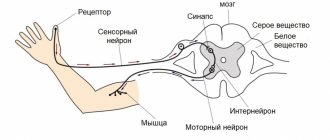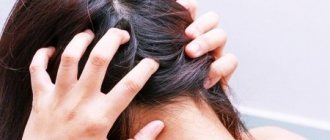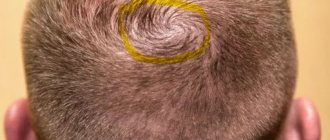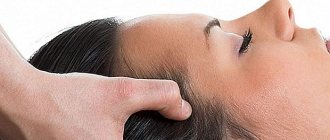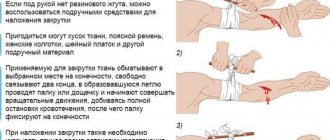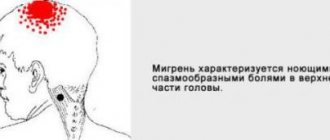Every cell of the human body has a connection with the nervous system - the ancient part of it, which we do not control, and the young cortex, which issues commands from consciousness. The message is carried out using nerve fibers, and they can exist normally if they are not under pressure from the outside and are not damaged from the inside. When such a situation does arise, it manifests itself as a sensation as if goosebumps are running down the skin. Then this symptom is not associated with the experience of any emotions and does not go away after switching to another thought.
Let us examine in more detail what this or that localization of these unpleasant sensations may mean, and what the duration of the “goosebumps” indicates.
Types and mechanism of “goosebumps”
The sensation of tingling and crawling is medically called “paresthesia.” They appear in response to irritation of nerve endings, the brain or spinal cord. The nature of this phenomenon is as follows: the sensitive nerve ending receives several different unrelated signals at once, layering on top of each other. As a result, the nerve does not know how to react correctly to this variety, and “turns on” numbness, burning, “pins and needles” or tingling.
Paresthesia is usually felt below the irritated area of the nerve. They may be accompanied by “goose bumps” - “pimples” in the area of hair growth, which is an analogue of the puffiness of fur or quills in animals.
Paresthesias can be:
- temporary, occurring when sitting in an uncomfortable position, freezing, sexual arousal, a feeling of euphoria from listening to music or when negative emotions appear. They are usually described as “pins and needles on your legs” and go away when the irritating factor stops. Not accompanied by cramps, pain or sensory disturbances;
- chronic, recurring. They are signs of the disease, and can be accompanied by two types of symptoms:
- indicating damage to the nerve fiber. These are: numbness in the limbs or only in the fingers, tingling sensation, goosebumps. Sometimes local twitching (convulsions) develops here;
- indicating damage to those nerves that are connected to the vessels of this area. This is evidenced by: pale skin, deterioration of temperature and pain sensitivity, cool temperature, hair loss.
Transient (temporary) paresthesia is a variant of the norm and does not require medical intervention. If “goosebumps” run without any visible effect on the skin, you definitely need to look for their cause and eliminate it.
The doctor explained why goosebumps appear and run all over the body
Photo: depositphotos/HayDmitriy
Immunologist Anna Shulyaeva explained why goosebumps appear and run on the body, reports the Arguments and Facts website.
She noted that in most cases this phenomenon is completely harmless. Most often, goosebumps appear as a result of a reflex to danger. This effect is a human atavism, and animals protect themselves in this way.
“Most often, such a reaction is observed in response to some external stimuli, and goosebumps appear on their own, unexpectedly and not always on time,” Shulyaeva noted.
She added that the cause of goosebumps is most often an emotional outburst or hypothermia. In a normal reaction, the effect wears off without any consequences after a few seconds. At the same time, goosebumps may be evidence of some kind of pathology.
Shulyaeva noted that if they appear for no apparent reason, then this may be a reaction to neurological disruptions in the body. In this way, the body tries to tell about damage to the nerves or nerve endings.
“Also among the reasons may be vitamin deficiencies, the appearance of some neoplasms that compress the nerves. This situation can occur spontaneously and against the background of problems with blood vessels. In this case, it is recommended to visit a phlebologist for a detailed study of the situation, diagnosis and treatment,” Shulyaeva said.
She added that pain or numbness in the limbs that occurs after the appearance of goosebumps may also be a reason to see a doctor. In addition, the effect of running, as if goosebumps ran all over the skin, is considered a deviation from the norm. This may be a consequence of a lack of vitamins or insufficient oxygen supply to the tissues.
In addition, among the reasons it is worth noting a lack of collagen. In such cases, the skin begins to peel off and irritation begins to appear on it. In this case, you need to adjust your diet, making it more fortified, which a specialist can help with.
The chills and tremor of the limbs can also be masked by the chills effect. This may indicate problems with the thyroid gland, and therefore you need to consult an endocrinologist. The appearance of goosebumps on the left side may indicate problems with the heart and blood vessels, especially if they last more than 5 minutes and are accompanied by trembling.
If, in addition to the appearance of goosebumps, chronic fatigue, heaviness, swelling or numbness in the legs appear, then it is necessary to undergo a full medical examination. It is especially worth paying attention to the performance of blood vessels and the presence of plaques in them.
Earlier, dermatologist Svetlana Zhaboeva gave recommendations on skin care in case of sunburn. She noted that the first step is to wash your face to eliminate sweat and dirt. Then you need to apply a soothing cream to the skin.
What diseases provoke paresthesia?
The causes of goosebumps are varied. Let's list them first:
- osteochondrosis;
- damage to nerve fibers of various localizations - neuropathy;
- high blood glucose levels;
- impaired nutrition of nerve fibers due to diabetes mellitus, poisoning, including chronic alcohol intoxication - polyneuropathy;
- low blood levels of calcium or magnesium;
- nerve fiber injury;
- damage to nerve fibers by antibodies;
- varicose veins;
- migraine;
- Raynaud's syndrome;
- atherosclerosis of arterial vessels;
- insufficient intake of vitamins B1, 6, C;
- arthritis;
- restless legs syndrome;
- tumors of nerve fibers;
- tumor in the parietal lobe of the brain;
- autoimmune vascular damage - vasculitis;
- insufficiency of parathyroid gland function – hypoparathyroidism;
- neurasthenia;
- obliterating endarteritis;
- multiple sclerosis;
- trigeminal neuralgia;
- stroke;
- taking certain medications;
- shingles;
- rabies;
- follicular hyperkeratosis;
- entry of the filling mass into the canal of a tooth with a living nerve;
- damage to the nerve ending during tooth extraction.
If “goose bumps” is the name given to the external manifestation – “goose bumps”, without any other symptoms, then this pathology is called follicular hyperkeratosis.
Here, due to poor nutrition of the skin or constant irritation, the upper layer of the skin thickens excessively, and the mouths of the hair follicles become inflamed. Dermatocosmetologists treat pathology with various local and systemic means.
Goosebumps on the body, arms and legs
This symptom is accompanied by many diseases. Let's consider the main ones in more detail.
Hypovitaminosis B1
Vitamin B1 is needed for the normal functioning of the nervous system. It is involved in the production of acetylcholine - a substance that allows a nerve impulse to reach the muscle, intestines, sweat gland, heart - and transmit its command to it. Its insufficient intake from food or acceleration of its breakdown leads to:
- feeling of pins and needles on the legs and arms;
- irritability;
- headache;
- memory impairment;
- constipation;
- increased heart rate;
- pain in the heart;
- swelling;
- shortness of breath;
- sometimes even paralysis and cardiovascular failure.
Such symptoms require prompt diagnosis and treatment: administration of synthetic vitamin thiamine and diet correction.
Hypoparathyroidism
This is a reduced function of the parathyroid glands, in which the level of calcium in the blood decreases. It manifests itself not only as goose bumps in the limbs, but also:
- painful contractions of the muscles of the limbs, body and face: the arm is brought towards the body, it is “bent” at the wrist and elbow joints, the corners of the mouth are lowered, the eyelids are lowered by half, the body is arched back;
- swallowing is paroxysmally impaired;
- there is a stabbing pain in the abdomen;
- there may be vomiting, diarrhea;
- fainting occurs;
- twilight vision is impaired;
- "pawns ears;
- there are pains and interruptions in the heart;
- hair becomes thinner, the number of hair shafts falling out increases;
- the skin is peeling;
- a large number of teeth are affected by caries;
- nails become dull;
- With prolonged absence of therapy, cataracts develop.
Decreased calcium levels
Here the same symptoms develop as with hypoparathyroidism, but they are not as pronounced and occur more easily. Often, the pathology is manifested only by painful spasms of the muscles of the limbs and face, which immediately follow goosebumps, increased heart rate, trembling and recurrent vomiting. With an extremely low level of this electrolyte in the blood, difficulty breathing may develop until it stops, and painful arching of the entire body.
Low blood magnesium levels
This condition manifests itself:
- weakness;
- lack of appetite;
- nausea, vomiting;
- trembling of the body or individual muscles;
- Convulsions may occur in which the entire body contracts or arches. This is most common in children.
Taking medications
The appearance of goose bumps can be caused by taking drugs such as: Ofloxacin, Protionamide, Isonazid, Cycloserine, drugs against epilepsy and blood pressure lowering drugs.
Arrhythmias
In the case of the development of attack-like (paroxysmal) rhythm disturbances, a person may notice:
- “goosebumps” running over the body;
- chills at normal body temperature.
This state lasts from ten minutes or more; most often develops at night.
Brain stroke
Paralysis or partial immobility of the limbs on one side may be preceded by a feeling of numbness and crawling, sometimes on the opposite side. There is also a headache, there may be short- or long-term loss of consciousness, focal symptoms are observed: facial asymmetry, different widths of the palpebral fissures, inability to speak or understand speech.
Damage to the parietal lobe of the brain
A tumor or encephalitis that develops in the lobe responsible for sensitivity is accompanied by other symptoms: the inability to perform complex actions, failure to recognize objects if you close your eyes and feel them with your hands, loss of the ability to write. There may also be loss of half of the visual field and loss of awareness of one's own body diagram.
Guillain-Barre syndrome
This condition occurs after a viral infection (mainly colds and herpes), or intestinal infection caused by the Campylobacter bacterium or enteroviruses.
Here, in the period from 5 to 21 days after the illness, antibodies are formed to certain areas of the spinal nerve roots. This is manifested by the appearance of pins and needles on the legs, the range of movements gradually decreases, and sensitivity is impaired. The process may appear immediately on your hands. It may involve a certain volume, but may spread towards the chest. The last symptom is very dangerous and requires urgent hospitalization in the intensive care unit, as it can progress to respiratory arrest.
Head injury
A brain contusion can lead to the appearance of pins and needles on both one and two sides. After this, loss of sensation may develop.
Shingles
The disease is caused by the same virus as chickenpox; occurs in those who have already had it. It manifests itself as the appearance of goosebumps in the projection of any nerve, but more often - one of the intercostal nerves. Goosebumps precede the appearance of redness here, on which bubbles with transparent contents soon appear. The affected area burns and hurts.
Multiple sclerosis
This is an autoimmune pathology when one’s own antibodies begin to attack the membrane of most nerve fibers, as a result of which the latter become “naked” and begin to destroy themselves. There is no clear sequence or algorithm for damage to fibers, so it is difficult to recognize the disease.
Most often, it begins with deterioration of vision in one eye, the sensation of a foreign body in it, and the appearance of blurred contours of the objects in question. This condition lasts about a week, then goes away on its own, but not completely. Subsequently, the symptom will recur. Gradually, it leads to disruption of coordinated eye movements and a change in the normal reaction of the pupils to light. Usually, after this, goosebumps and pain appear on the face, which is the basis for making a diagnosis of “Facial neuritis” or “Trigeminal neuralgia”. Later, loss of coordination, changes in handwriting, and transient trembling of objects develop.
Also, the initial manifestations of the disease include goosebumps, burning, numbness or tightening of the skin that occurs on any part of the body. It goes away on its own and often does not serve as a reason to contact a neurologist or therapist.
Polyneuropathy
This disease is characterized by damage to the peripheral nervous system due to poisoning (including alcohol surrogates), metabolic disorders (mainly due to diabetes mellitus). It is dangerous because the disconnection of nerves, starting from distant parts of the body (fingers and toes), spreads closer and closer to the respiratory muscles, and can also involve the nerves that command the contraction of the muscles responsible for breathing.
Polyneuropathy manifests itself as a deterioration in the motor activity of the legs and arms, starting with the fingers, the appearance of goosebumps and numbness in these areas, and the gradual “turning off” of sensitivity in the areas of socks and gloves.
Goosebumps
Diabetes
Iron deficiency
62392 09 December
IMPORTANT!
The information in this section cannot be used for self-diagnosis and self-treatment.
In case of pain or other exacerbation of the disease, diagnostic tests should be prescribed only by the attending physician. To make a diagnosis and properly prescribe treatment, you should contact your doctor. The feeling of crawling on the skin: causes of occurrence, what diseases it occurs with, diagnosis and methods of treatment.
The human nervous system, with the help of reflex impulses, influences organs and tissues, helping the body adapt to changing environmental conditions. A reflex is understood as a response mediated by the nervous system to any stimulus (external or internal).
Throughout life, a person acquires some reflexes and loses others. However, there is a group of reflexes with which we are born and live. These include the so-called goosebumps, or pilomotor reflex.
The pilomotor reflex is an involuntary contraction of the smooth muscle structures at the base of the hair follicle, as a result of which the hairs rise to cover the surface of the skin.
Evolutionarily in animals, this reflex contributes to at least two things. Firstly, creating an additional air layer between the animal’s skin and the environment, which makes it possible to retain heat and protect against hypothermia. Secondly, with the help of the pilomotor reflex, the animal takes on a more intimidating appearance, which helps in intimidating enemies.
In humans, the pilomotor reflex has lost its former significance. However, goosebumps, or goosebumps as they are also called, have occurred to everyone more than once. The feeling of goose bumps on the skin is a type of paresthesia.
Paresthesia is understood as an unusual, pretentious feeling created by tactile receptors in the absence of their actual irritation. Other types of paresthesia include an unexplained feeling of tingling, burning, etc.
Types of goosebumps
The feeling of goosebumps on the skin can cover the entire surface of the body or occur only in a certain area, i.e. be localized. In some cases, it may be transitory, situationally determined and therefore not bring much discomfort. In others, paresthesias are long-lasting and persistent, then they can reduce the quality of life and become a cause for concern and see a doctor.
Possible causes of goosebumps
The occurrence of goosebumps is based on a reflex response of the nervous system. The reflex can be triggered both by stimulation of receptors - peripheral nerve endings (for example, cold receptors under the influence of cold air or cold water), and by stimulation of structures located in the central nervous system, for example in the brain.
This is typical for the appearance of goosebumps on the skin when a feeling of aesthetic or other pleasure or fear arises.
With inadequate stimulation of certain nervous structures, a person also develops piloerection (raising of hairs), which is characteristic of various diseases accompanied by damage to the nervous system. Peripheral nerves are most often affected, and, as a rule, the pathological process spreads from the smallest branches of nerves upward, capturing larger and larger nerve structures. Therefore, the appearance of paresthesia may be the first symptom of the disease.
What diseases can cause the feeling of crawling on the skin?
First of all, it is worth highlighting a group of diseases accompanied by primary damage to nerve fibers (neuropathy). These include:
- diabetic polyneuropathy
, which occurs with an uncontrolled persistent rise in blood glucose levels; - polyneuropathy
caused by a lack of vitamins and nutrients in the body, for example iron, vitamins B, C; - toxic polyneuropathy
, which occurs under the influence of toxins entering the body from the outside or being metabolic products; - alcoholic polyneuropathy
- damage to peripheral nerves by metabolic products of ethyl alcohol, is a special case of toxic neuropathy; - autoimmune diseases
, accompanied by nerve damage due to abnormal activation of immune system cells against the body's own tissues; - demyelinating diseases
, for example, multiple sclerosis, characterized by the destruction of nerve sheaths; - post-traumatic neuropathy
, which occurs due to mechanical effects on nerve fibers; - neuropathy associated with degenerative changes in the spine
, leading to compression of the nerves and disruption of their functioning; - hereditary degenerative diseases
of the nervous system, for example, Charcot-Marie-Tooth disease, one of the symptoms of which is various paresthesias.
The cause of the unpleasant sensation in the form of goosebumps crawling on the skin may be a pathological focus in the brain
(gliosis, tumors, etc.).
A range of mental illnesses
One of its symptoms is the appearance of paresthesia.
In patients with epilepsy
Paresthesias often appear as part of the “aura”, i.e. subjective sensations foreshadowing the imminent development of an epileptic attack.
Other reasons for the appearance of goosebumps include, for example, poor circulation
in one or another part of the body, leading to oxygen starvation of tissues.
Which doctors should you contact if you experience a crawling sensation?
Traditionally, the diagnosis and treatment of paresthesia, a type of which is the feeling of crawling on the skin, is dealt with, because this phenomenon is directly related to the functioning of the nervous system. However, if the cause of nerve damage is a somatic disease, i.e. disease of internal organs, then in addition to a neurologist, such a patient is seen by a vascular surgeon and other specialists, depending on the underlying disease.
Diagnosis and examinations for goosebumps
The causes of paresthesia are extremely diverse, therefore, when you come to your appointment, you need to be prepared for the fact that the doctor will be interested in how long ago the crawling sensation appeared, changes in diet, lifestyle, taking medications and supplements, past infectious diseases, travel to other countries, and etc. After a comprehensive clinical study, the most likely cause of the feeling of crawling on the skin will be determined, and depending on it, the patient will be referred for additional laboratory and instrumental studies.
- General blood test with leukocyte formula to exclude anemia, infectious and inflammatory processes, etc.
Goosebumps on the face and hands
If goosebumps crawl on the skin of your face and hands, this may be one of the following pathologies.
Migraine
At first, goosebumps appear on the face (especially around the mouth) and hands, then a headache develops mainly in one half of the head. In this case, paresthesia should be regarded as a migraine aura - a condition that precedes an attack of pain.
Tumor or inflammation of the frontal lobe of the brain
A change in personality (a person becomes “not the same as usual”) along with goosebumps in the lips and fingers may indicate damage to the frontal lobe. Only a neurologist can refute such a diagnosis, sometimes only on the basis of an MRI of the brain.
Goosebumps on the scalp
If you have goosebumps on the back of your head, it could be:
- Neuropathy of the greater occipital nerve. At the same time, goosebumps, numbness and tingling are felt in the area of the back of the head to the crown; here there is increased or decreased sensitivity. You can find pain points in the back of the head.
- Neuropathy of the cervical plexus with compression of its sensory nerves. Here in the area of the back of the head, neck, shoulder girdle and behind the ear, pain and goosebumps are felt.
- Transient ischemic attack (ministroke). In this case, the tingling sensation is felt for 1-2 hours, then disappears, leaving no focal changes.
- Bell's palsy. At first, goosebumps are felt on one side of the face, after which weakness of the muscles on this side appears, and then they completely cease to provide movement to one side of the mouth and facial muscles.
What diseases can cause goosebumps?
As mentioned above, goosebumps can be a symptom of the presence of some pathological process or disease in the body. “Goose bumps” in the scalp area may well be the result of the following conditions:
- dysfunction of the occipital nerve (neuropathy). Due to this dysfunction, unpleasant sensations in the form of constant numbness, tingling and goosebumps may occur in the back of the head. The affected area may be partially numb to touch;
- transient ischemic attack - disruption of the nutrition of brain tissue due to a sharp narrowing of the vessel. In such a situation, the goosebumps continue for several hours, after which they simply disappear;
- cervical plexus neuropathy. Painful sensations and goose bumps with this disorder will be concentrated in the back of the head, neck and near the ears;
- Bell's palsy is inflammation of the facial nerve. With this problem, first goosebumps begin to actively run along the right or left side of the face, after which the muscles on this side weaken and gradually cease to provide movement of the part of the face altogether;
- hypoparathyroidism is a disorder of the parathyroid glands. The localization of goosebumps may vary, but the problem is also accompanied by increased nervous excitability.
Goosebumps on your hands
If you notice goosebumps crawling on your arm, please note: this may be due to the following reasons.
Anterior scalene syndrome
When this muscle is overstrained, which is caused by compression of the lower trunk of the brachial plexus and the subclavian artery, pain and pins and needles are noted in the arm - from the shoulder to the little finger and ring finger. When turning the head, the pain radiates to the back of the head and chest. There may be numbness and chilliness in the hand, and the skin becomes pale or more bluish.
Brachial plexus syndrome
It is characterized by deterioration of movement in the hand, goosebumps and decreased sensitivity in the part of the hand that is located on the little finger side.
Raynaud's disease
Manifested by coldness and paleness of the fingers. Goosebumps crawl over them, the fingers first turn blue and begin to hurt, then their skin turns red, and the pain subsides. Often not only the fingers, but also the toes are affected.
Osteochondrosis, trauma, spondylolisthesis or tumor of the cervical spinal cord
These diseases are characterized not only by the appearance of goose bumps in the hands, but also by pain in the muscles of the hands, a gradual decrease in strength in their muscles, and a deterioration in temperature and pain sensitivity in the hands. If a pathological process (tumor, edema or vertebrae) compresses the vessels leading to the brain, dizziness, hearing or vision impairment will occur.
Myositis of the cervical muscles
Goosebumps in the arms are accompanied by pain in the neck. These symptoms are worse in certain positions of the neck. Read more about myositis.
Costoclavicular syndrome
This is the name for compression of the vessels and nerves of the brachial plexus, which occurs in a vertical position if the shoulder girdle is pulled back and down (for example, when carrying a heavy backpack). In this case, pain when standing at attention, accompanied by goosebumps, develops along the inside of the hand and forearm.
Musculocutaneous nerve neuropathy
This nerve gives commands to many muscles of the shoulder, including the biceps, reaching the forearm, it is divided into anterior and posterior branches. If the nerve is pinched at the level of the elbow fold, pain occurs in this place, which radiates to the side of the forearm and is accompanied by a burning sensation and goosebumps. The pain intensifies with flexion and extension of the elbow, and rotation of the forearm in and out.
Compression of the median nerve in the axillary fossa
The pathology occurs mainly when carrying heavy objects resting on the armpit, as well as when spouses sleep together, when the head of one of them is under the arm of the other.
Here goosebumps run across the palm; at first this is not accompanied by pain or dysfunction. If a similar situation with compression is repeated, the work of the flexor muscles of the palm and those muscles that are responsible for flexing the thumb and index fingers worsens. The palm loses its sensitivity; the muscles that form the eminence of the thumb are hypotrophied.
Intermetacarpal tunnel syndrome
This is the name of the condition when the nerve is pinched by the heads of the metacarpal bones. Symptoms: numbness and pins and needles in the area of the surfaces of the fingers facing each other, which intensify with flexion and extension of the fingers.
Pinched nerve between the heads of the triceps muscle
The causes of the condition are injury to the back of the arm, fracture of the humerus.
Symptoms: deterioration or inability to straighten the hand; if you press on the back of the forearm, pain and pins and needles appear near the thumb.
Compression of the dorsal branch of the ulnar nerve
This occurs due to the habit of resting your elbow on the edge of the table. Pain occurs on the inside of the hand. If you press on the inside of the wrist, the pain intensifies and a pins and needles sensation appears.
Why do people get goosebumps when listening to pleasant music?
“This music gives me goosebumps,” probably each of us has heard or said these words in our lives. At the same time, we hardly thought about where these goosebumps come from. Scientists decided to answer this question: a team of psychologists from Eastern Washington University found out why some people experience pleasant sensations when listening to music, such as a slight tingling of the skin or goosebumps (scientists call them frisson
, which translated means “trembling”, “shudder”).
The same sensations can occur when watching a touching scene in a movie or when making physical contact with a loved one. The results of the scientists' work were published
in the journal Psychology of Music.
According to research, not all people experience such goosebumps.
Where does absent-mindedness come from?
British scientists conducted a study and found out why people often become victims of pickpockets. About…
22 March 19:17
Thanks to previous work on the topic, scientists knew that most people are able to accurately name the moment in a piece of music during which they experienced a tremor. Typical examples of such cases are unexpected musical harmony or a sudden introduction of a voice (for example, a solo). This was explained by the fact that such musical surprises evoke a charge of positive emotions.
Study authors Mitchell Colver and Amani el-Alayli suggested that people who experience goosebumps when listening to music are highly developed in the trait “openness to experience,” one of the five personality dimensions included in the Big Five model, along with extraversion and neuroticism. , kindness and integrity. Scientists note that people in whose character the trait of “openness to experience” manifests itself especially strongly have a good imagination, strive to acquire new knowledge, quickly remember new information, and also, as a rule, have a rich vocabulary.
The Big Five model evolved from the work of psychologists Gordon Allport, Hans Eysenck and Raymond Cattell. The Big Five assumes that each person is a carrier of the traits listed above, independent of each other. All of them manifest themselves in the character of an individual to varying degrees -
knowing which one, you can predict
a person’s behavior in certain situations, build his correct psychological portrait, and also detect a personality disorder.
Previous studies have examined musical goosebumps using fMRI, a type of magnetic resonance imaging that measures hemodynamic responses (changes in blood flow) caused by neural activity in the brain or spinal cord. fMRI has made it possible to study the process of tremor development in stages.
Dance while you are young
On April 29, people around the world celebrate International Dance Day. About what type of dance is best to choose...
29 April 14:42
The current experiment involved 113 students who completed the full version of the Big Five NEO-PI-R (full version includes 240 questions). Subjects then listened to five pieces of music that are most likely to give people goosebumps, selected from previous studies. They included the following compositions: Bach’s “St. John Passion” (the first 2 minutes 11 seconds of the work), Chopin’s “Piano Concerto No. 1” (the first 2 minutes 18 seconds), the song “Making Love Out of Nothing At All” duet Air Supply (first 53 seconds), the vocal symphony “Mythodea” by the Greek composer Vangelis (first 3 minutes 21 seconds. By the way, it was this symphony that became the official music of NASA’s Mars Odyssey mission, launched in 2001), as well as works by “Oogway Ascends" by Hans Zimmer (first 2 minutes).
The condition of the participants was recorded using the galvanic skin response (GSR) method - a bioelectric reaction recorded from the surface of the skin, as well as by their own assessment. GSR, like fMRI, made it possible to trace the stages of the occurrence of goosebumps.
As a result of the experiment, the researchers' assumptions were confirmed: the frequency of trembling was positively correlated with the participants' openness to experience. Nevertheless, scientists managed to find out new facts.
If the results of previous studies stated that people with a developed “openness to experience” often experience goosebumps from music due to their high emotionality, now scientists have stated that the main role here is not played by emotions, but by the cognitive component.
Goosebumps arise because a person with developed intellectual abilities is able to mentally make certain assumptions about how the melody will develop further. And if these predictions coincide with reality, trembling appears.
By the way, people can experience pleasant sensations - such as goosebumps or a pleasant tingling of the skin - not only from listening to music. In 2010, the term “autonomous sensory meridian response” (ASMR, autonomous sensory meridian response) appeared on the Internet, which refers to the appearance of goosebumps or tingling of the skin in response to various external factors: sounds, visual and cognitive stimuli, as well as situations associated with showing attention to a person.
The bourgeoisie is the engine of art
Passion for art is determined by education, not class, British scientists have found.
18 September 17:31
Such factors may include a quiet whisper, the faint rustling of paper, watching another person draw or write, talking to a hairdresser or doctor, styling hair or applying makeup, or receiving selfless help from someone. Experts say that the phenomenon of ASMR is still difficult to study and has not been explained from a scientific point of view. Thus, Tom Stafford, lecturer in psychology and cognitive science at the University of Sheffield, commented
:
“This may indeed be a real phenomenon, but so far it has not been researched.
Our inner experiences are the subject of numerous psychological studies, but when it comes to something that cannot be seen and felt and at the same time not everyone is able to feel it, it becomes a “blank spot”. Like with synesthesia, it was a myth for many years, and then the tools to study it became available in the 1990s.”
Although there is no scientific evidence for the existence of an autonomous sensory meridian response, a large number of videos and audio recordings created specifically for those experiencing ASMR can be found on the Internet. In these recordings, people whisper stories, fold origami, and tap on wood. Asmrtists—that’s what the creators and fans of such videos call themselves—even have their own radio
. According to ASMRists, watching videos and listening to specific sounds allows them to relax, calm down, get positive emotions and even fall asleep.
Goosebumps on my feet
The symptom of goosebumps “running” down the leg is caused by various conditions. Let's look at the main ones.
Lumbar plexus neuropathy
It appears due to compression of the plexus by altered upper lumbar vertebrae, hematomas, abscesses, phlegmons, and tumors in this area.
Symptoms: pain and pins and needles - in the lower abdomen, in the pelvic area, on the thigh. They intensify when the extended leg is raised upward.
Varicose veins
The legs, especially when standing for a long time and at the end of the working day, itch, swell, and feel heaviness. Dilated veins and purple vascular networks are visually identified.
Restless legs syndrome
This is the name of a condition caused by various reasons, when a burning, tingling, feeling of bursting or squeezing is felt in the legs, due to which the lower limbs perform a frequent reflex movement of “throwing off”.
To clarify and eliminate the cause of such sensations, contact a therapist and neurologist.
Bernhardt-Roth disease
It manifests itself:
- goosebumps, burning, numbness, tingling in the area from the hip joint along the anterolateral surface of the thigh to the knee;
- pain and pins and needles intensify when walking, disappear if you sit or lie with your legs bent;
- if you touch the skin in this area, it will hurt, you will feel a feeling of heat, a prick;
- sensitivity here is increased;
- There may be both dry skin and increased sweating in this area.
After lumbar puncture
Injury to the nerve roots during lumbar puncture can lead to pain, loss of sensation in the legs, and weakness in their muscles.
Operations on the spinal cord, spinal nerves, spine
If the nerve roots were injured during the intervention, the following occurs:
- goosebumps in the legs;
- weakness of the leg muscles;
- decreased sensitivity in the legs.
Raynaud's disease
It manifests itself as pain and coldness of the fingers, then the fingers turn blue, which is accompanied by increased pain. Then the vascular spasm goes away, the fingers turn red, and the pain and goosebumps go away.
Femoral nerve neuropathy
It can be caused by a fracture of the pelvic bones with bleeding into the muscles surrounding this nerve. It may occur if the nerve was injured during puncture of the femoral artery, or if it was compressed by lymph nodes or a hematoma localized in the area of the inguinal fold.
Symptoms:
- pain – in the groin area;
- spreads to the lumbar region, to the thigh and lower leg along their anterior internal surface;
- Here goosebumps are detected and sensitivity is reduced;
- flexion-extension of the hip and knee may be performed in too small a volume;
- climbing stairs is especially difficult.
Clamping of the saphenous nerve
Pins and needles, pain and loss of sensitivity are determined along the inside of the leg from the knee to the big toe.
Rabies
The disease occurs as a result of the bite of an infected animal, which introduces the rabies virus into the wound. Pathology manifests itself as the appearance of goosebumps in the bitten leg. Subsequently, fear of light, water and sound develops.
How to call?
The feeling of goosebumps can be quite pleasant if you induce it yourself (or if you cause goosebumps to “run” on the skin of a loved one). To achieve this effect is very simple, you can:
- Run over the skin with the tips of your nails (without pressing), a feather or other suitable object.
- Blow on the skin (especially hot skin).
- Touch your skin with an ice cube.
Experts have come to the conclusion that a variety of factors that stimulate the activity of the sympathetic nervous system, which normally responds to a threat, can trigger the feeling of goosebumps on the skin. Such a reaction can occur due to unexpected influence:
- Music.
- Specific sounds - from the rustling of leaves to the scratching of nails on a board.
- Tastes (especially strong ones).
- Movies.
It is impossible to predict in advance exactly how the body will react to a particular stimulus. But it is known for certain that the ability to cause pleasant “goosebumps” helps reduce pain or increase sexual pleasure.
Goosebumps on the tongue
This is typical for:
- rubbing with dentures;
- changes in bite resulting from the removal of one or several teeth;
- galvanization, when an electric current occurs due to the fact that the crowns are made of different metals;
- getting filling material into the canal;
- hypovitaminosis B12;
- damage to the sensory fiber of the glossopharyngeal nerve;
- inflammation of the arachnoid membrane of the brain;
- peptic ulcer of the upper digestive system;
- diseases of the ENT organs: sinusitis, rhinitis.
Goosebumps in the back area
Goosebumps “run” down the back when there is a pathology of the spine, such as spondylosis. If the vertebrae in the cervical region are deformed, then goosebumps and pain will be felt in the neck, crown and upper back; they intensify with certain movements. If similar symptoms develop in the thoracic region, we are most likely talking about spondylosis or osteochondrosis of the thoracic region. Finally, in pathologies when the nerves coming from the lumbosacral region are pinched, goosebumps will be felt in the lumbar region.
Algorithm for analyzing the state when “goosebumps” appear
Before you panic, remember what caused the paresthesia. It is also important to assess your condition as objectively as possible and notice additional symptoms:
| Then the goosebumps appeared | Where are they felt? | Additional symptoms | What could it be | Which doctor should I contact? How to confirm? |
| After a spinal injury | In the limb area | Numbness, impaired sensitivity and movement in the limbs. With a cervical injury, there may be dizziness and loss of coordination. No goosebumps | Fracture, fracture-dislocation of vertebrae | Neuropathologist X-ray or computed tomography of the spine in the injured area |
| For no reason, but more often - if a person suffers from thrombosis, arrhythmias, hypertension | In the area of one half of the body | Sudden onset of poor sensitivity and inability to move the arm and leg on one side | Stroke | Neuropathologist Examination by an ambulance doctor, a neurologist, computed tomography of the brain performed under the supervision of a resuscitator |
| For no apparent reason | In the area of the limbs, but not on one side of the arm or leg, but grabbing either the foot (hand), or the foot and lower leg (hand and forearm), or the entire limb | Numbness, pallor of the skin, decreased local temperature, hair loss or decreased growth in the area where the “pins and needles” sensation is felt | Poor arterial patency: obliterating atherosclerosis or obliterating endarteritis. There may also be nerve compression | Vascular surgeon, neurologist Ultrasound with Dopplerography of the arteries of the extremities (both). Examination by a neurologist, checking tendon reflexes, electroneurography |
| With frequent alcohol consumption | In the area of the extremities (lower, upper or all) | The same | Alcoholic polyneuropathy | Examination by a neurologist, checking tendon reflexes |
| After an arm/leg injury | In the area of injury, above and below the point of impact | Feeling of “pins and needles”, decreased or increased sensitivity to cold/heat, muscle weakness of only this limb | Nerve fiber injury | Examination by a neurologist |
| After working with paints or heavy metals | Legs, arms | “Goosebumps” on the extremities (usually the legs), while sensitivity in the toe area decreases, and the muscles there become weak. Weakness and decreased sensation may also be observed in the hands, in the glove area, and spread along the arms/legs towards the torso | Toxic polyneuropathy | Examination by a neurologist, determination of sensitivity and tendon reflexes |
| If you have diabetes | In the area of both or four limbs | “Goosebumps” on the legs/arms, decreased sensitivity, muscle weakness | Diabetic polyneuropathy | Endocrinologist together with a neurologist Blood test for sugar (glucose) level, glycated hemoglobin level, electromyo- and electroneurography |
| For no apparent reason | In the area of the lower/upper or all 4 limbs | Changes in temperature and pain sensitivity, cold skin, muscle weakness | Vitamin deficiency (most likely B1) | Therapist – for adults, pediatrician – for children Examination by a neurologist, determination of the level of vitamins in the blood |
| During pregnancy | In the leg area | There are signs of pregnancy. There may be night cramps | Lack of magnesium or calcium | Therapist Determination of calcium and magnesium in blood |
| For no apparent reason | Both on the body and on the limbs | A persistent low fever that does not decrease with antibiotic treatment, but goes away on its own. Often - spots on the skin, there may be a “mesh pattern”. Losing weight. Pain in muscles, joints | Vasculitis | Therapist, rheumatologist Rheumatology tests, LE cells and other tests prescribed by a rheumatologist |
| Against the background of the same type of work | In a separate area of the limb (less commonly, the body) | Pain in this area, loss of sensitivity, “pins and needles”. Pass through time | Pinching or inflammation of a single nerve fiber | Neuropathologist Examination by a neurologist, determination of sensitivity and tendon reflexes |
| After a cold, intestinal infection, vaccination, surgery | It starts from the feet, can end there, and can rise, capturing the legs, thighs, hands, and forearms. Breathing, swallowing, and regulation of vascular tone may be impaired | Numbness, loss of sensitivity, muscle weakness, impaired movement of the limbs or their parts, up to paralysis, which can be treated if started in a timely manner. When immobilization of the limbs occurs, the “goosebumps” disappear | Infectious-allergic polyneuropathy (Guillain-Barré or Guillain-Barré-Landry syndrome) | Neuropathologist, sometimes together with infectious disease specialists Examination by a neurologist, determination of sensitivity and tendon reflexes |
| Either for no reason, or after suffering from acute respiratory viral infection | In any area, but more often - between the ribs | Chickenpox-type blisters are observed in the affected area. This is also accompanied by a burning sensation and pain when breathing | Herpes zoster | Infectious disease specialist together with a neurologist |
| For no apparent reason | Hands, face, mouth area | After goosebumps there is a headache, usually in one half of the head | Migraine with aura | Examination by a neurologist |
| After hypothermia | Separate area of the face | Pain in this area, lacrimation, increased sweating on this side | Trigeminal neuralgia | Examination by a neurologist |
| After an animal bite | At the site of the bite | Increased sensitivity of this area, sensation of a “twitching” muscle, photophobia, hydrophobia | Rabies | The diagnosis is made based on examination by an infectious disease specialist/radiologist |
| For no apparent reason | In any area | Accompanied by a completely different set of neurological symptoms: headache, loss of coordination, decreased vision, loss of sensitivity in any areas of the skin of the face, limbs, and torso | Multiple sclerosis, some mitochondrial diseases | MRI of the brain and cervical spinal cord with contrast, electroneurography, laboratory tests that will be prescribed by a neurologist after examination |
| For no apparent reason | “Goosebumps” appear in paroxysms on any part of the body, the location of which may vary. Most often they are felt in the back of the head | Distorted perception of one's own body parts, failure to recognize objects, inability to perform complex movements, loss of the ability to count and solve arithmetic problems. There may be loss of visual field | Damage (usually by tumor) to the parietal lobe of the brain | Neuropathologist MRI of the brain |
| After hypothermia of the head, overload of the neck muscles. Maybe for no apparent reason | In the back of the head | Severe pain in the back of the head, such as “drilling”, “shooting”, occurs in attacks. During the interictal period, a dull pain in the back of the head may remain. You can find points on the back of the head, pressure on which increases pain and goosebumps | Occipital neuralgia | Examination by a neurologist |
If you have goosebumps:
- run around the local area, especially in the limbs,
- this is not accompanied by disturbances of consciousness, vision, breathing, swallowing,
- does not rise to the respiratory tract,
it can be any of the neuropathies of numerous nerves. This diagnosis is made by a neurologist based on a routine examination of the patient. We will not list all the diagnoses in the table, especially since their treatment is the same.
The following important information regarding paresthesia should also be noted:
- the lower (closer to the toes) the area where the goose bumps are located, the closer to the tailbone the pathology is located;
- a large area of goosebumps running from a large (hip or shoulder) joint to the fingers indicates a pathology of the spine, while the reverse movement (from the fingers upward) indicates nerve damage;
- if sensitivity is impaired, pain appears and goosebumps appear in a small area between the hand (foot) and shoulder (thigh), most likely a small nerve fiber is damaged (compressed);
- pain that occurs along with goosebumps
- Goosebumps and sensory disturbances are especially dangerous in patients with diabetes, as well as after an intestinal or cold illness;
- anxiety and an urgent visit to a neurologist should be caused by conditions when, along with goosebumps, it is discovered that the affected area does not distinguish what kind of - sharp or blunt - object has touched it, and also does not distinguish between hot and cold water;
- You need to visit a neurologist or vascular surgeon if the skin where the goosebumps run has turned pale, cold, and has little pale hair growing on it.
Goosebumps mainly on the left side of the body from the legs to the head
Elena
321 views
April 11, 2021
Good evening?!!! it started like this, but I don’t know if there is a connection... I was driving and suddenly a feeling of fear, as if fear of heights, took my breath away... in the summer my husband and I went to the sea, lay down to rest during the day, I began to fall asleep, but I had not yet fallen asleep and suddenly a feeling of fear, again took my breath away and I jumped up with the feeling that I was fainting, this did not happen every time, but once every 2 months!!! then tachycardia began, rarely once a month, then once every 2 weeks and so on until it began to happen almost every day, when I get up from sleep/I sleep normally, nothing bothers me/One fine day I had tachycardia for 3 hours, in the morning I woke up as if I was drunk/as if I was rocking in a boat/after a few days it became painful to look at the light, sounds were annoying, the left eye icon became larger than the right. I went to the doctors for the first ophthalmologist - the fundus was clean, the blood vessels were good, vision was 1, then, on the advice of the therapist, I started drips / Mexidol-Vinpocetine, Actovegin-Mexidol-25 pcs, no sense!!! then otolhinologist - 10 days of antibiotics - lencomecin and summed - no sense / suspected dandy / further - MRI of the head and spine in full and with contrast, in the head there is a small scar in the deep layers of the cerebellum 0.5 to 0.6 vascular in nature - does not fill with contrast - multiple sclerosis has been ruled out!! the spine has changes according to age, there are changes!! I repeated the MRI with the cerebellum after 2 months, still no new foci and there is no inflammation either and there was none at the time of the first MRI! then they started goosebumps all over my body every minute, as it seemed to me then, from my feet to my head, the neurologist passed all the cerebellar tests with a bang? It was breathtaking and it darkened before my eyes like fainting, but I foolishly didn’t fall - this state started every day, I could barely go to work, I had a sedentary job as a manicurist! I was 100% sure that I was dying, fear, anxiety since childhood, and at this moment completely wow!! after the otonerlogue it became easier, the motion seemed to go away, but when I move my eyes to the sides I still feel as if I’m about to turn to the side and it will stay that way, sensitive!!! vision and hearing have not decreased! further ultrasound of the neck - plaque 25% in the carotid artery, the neurologist asked to redo the ultrasound in a different place / haven’t done it yet / has diabetes mellitus, which I think is in remission - a strict diet without sugar and carbohydrates sugar - 4.7 in the morning - 7-7.8 after meals, weight 44 kg with a height of 146. then massage the trigger points - the tingling during the massage is terrible, especially when massaging the sciatic nerve!! 10 sessions - zero impact!!! the goosebumps more or less began to go away after 10 injections of neuromultivit. it became easier, but still tingles several times per day! There is no diagnosis other than diabetes! As soon as they find out that diabetes, that’s all over!! I already went to the neurosurgeons and they said everything is fine, look where it’s pinched!!! the last neurologist prescribed Grandaxin and Phenibut, but I haven’t started drinking yet!! constant anxiety, I have this feeling every day when I get out of bed, that something is going to happen , I get to the toilet and my heartbeat is already palpitating, although nothing bothers me at night! There’s still pressure on my nose, there was ringing in the ears during an exacerbation, now it’s rare!! Help me understand what’s happening to me!! The only person left is a psychotherapist because there’s still no diagnosis , except for diabetes and atherosclerosis, and the ultrasound hasn’t been redone yet
The question is closed
Feeling scared
What can cause goosebumps in children
Goosebumps in children can be caused by:
- Guillain-Barre syndrome;
- intoxication (due to diphtheria or poisoning) polyneuropathy;
- encephalitis affecting the parietal region;
- scalene muscle syndrome due to an accessory rib;
- neuropathies due to muscle spasms;
- vasculitis;
- arthritis;
- taking certain medications;
- spondylosis;
- lack of B vitamins;
- hypocalcemia or hypomagnesemia.
Author:
Krivega Maria Salavatovna resuscitator
